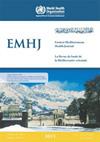关于伊朗伊斯兰共和国夜间睡眠时间与高血压之间性别特异性剂量-反应关系的人群横断面研究
IF 1.9
4区 医学
Q3 HEALTH CARE SCIENCES & SERVICES
引用次数: 0
摘要
背景:多项研究表明,睡眠障碍会对血压产生不利影响。然而,这些研究结果仍存在争议,只有少数研究调查了所有年龄和性别亚群的睡眠时间与高血压之间的关系。目的:利用 Ravansar 非传染性疾病队列研究,评估伊朗人群睡眠时间与血压之间的剂量-反应关系。研究方法这是一项横断面研究,研究对象是 2014-2017 年 Ravansar 非传染性疾病队列研究中 9865 名 35-65 岁的参与者。夜间睡眠时间分为≤5小时、6小时、7小时、8小时、9小时和≥10小时。使用 STATA 14 版的多变量逻辑回归分析了自我报告的睡眠时间与高血压之间的关系。限制立方样条分析显示了睡眠时间与高血压之间的剂量反应关系。结果显示经年龄调整后,男性高血压患病率为 16.50%,女性为 24.20%,总人口为 20.50%。与总人口的参考睡眠时间(7 小时)相比,睡眠时间为 9 小时的人群患高血压的多变量几率[OR(95% CI)]为 0.70(0.55-0.88),睡眠时间≤5 小时的人群患高血压的多变量几率[OR(0.74-1.09)]为 0.90(0.74-1.09)。在绝经前妇女中,我们观察到 9 小时睡眠时间与高血压呈反向关系[0.62(0.42-0.90)]。经年龄调整的三次样条曲线表明,在男性和总人口中,睡眠时间与高血压患病率之间呈线性反比关系,而在女性中则呈非线性关系。结论较长的睡眠时间(9 小时以上)与高血压呈负相关。还需要进一步研究,以确定伊朗伊斯兰共和国普通人群中与睡眠时间和高血压相关的风险因素。本文章由计算机程序翻译,如有差异,请以英文原文为准。
Population-based cross-sectional study of sex-specific dose-response associations between night sleep duration and hypertension in Islamic Republic of Iran
Background: Several studies have suggested that sleep disorders have adverse effects on blood pressure. However, the findings remain controversial and only a few studies have investigated the association between sleep duration and hypertension among all age and sex subgroups. Aim: To evaluate the dose-response association between sleep duration and blood pressure in the Iranian population using the Ravansar non-communicable disease cohort study. Methods: This was a cross-sectional study of 9865 participants aged 35–65 years from the 2014–2017 Ravansar noncommunicable disease cohort study. Night sleep duration was classified as ≤5 hours, 6 hours, 7 hours, 8 hours, 9 hours, and ≥10 hours. The association between self-reported sleep duration and hypertension was examined using multivariable logistic regression in STATA version 14. Restricted cubic spline analysis showed the dose-response association between sleep duration and hypertension. Results: The age-adjusted prevalence of hypertension was 16.50% among men, 24.20% among women and 20.50% in the total population. Compared with reference sleep duration (7 hours) in the total population, the multivariable odds ratio [OR (95% CI)] for hypertension was 0.70 (0.55–0.88) for the group with 9 hours sleep duration and 0.90 (0.74–1.09) for the group with ≤5 hours sleep duration. Among pre-menopausal women, we observed an inverse association between 9 hours sleep duration and hypertension [0.62 (0.42–0.90)]. The age-adjusted cubic spline suggested a linear inverse association between sleep duration and prevalence of hypertension among men and the total population and a non-linear association among women. Conclusion: Longer sleep duration (from 9 hours) had a negative association with hypertension. Further studies are needed to identify the risk factors associated with sleep duration and hypertension among the general population in the Islamic Republic of Iran.
求助全文
通过发布文献求助,成功后即可免费获取论文全文。
去求助
来源期刊

Eastern Mediterranean Health Journal
HEALTH CARE SCIENCES & SERVICESPUBLIC, ENV-PUBLIC, ENVIRONMENTAL & OCCUPATIONAL HEALTH
CiteScore
3.30
自引率
4.80%
发文量
112
期刊介绍:
The Eastern Mediterranean Health Journal, established in 1995, is the flagship health periodical of the World Health Organization Regional Office for the Eastern Mediterranean.
The mission of the Journal is to contribute to improving health in the Eastern Mediterranean Region by publishing and publicising quality health research and information with emphasis on public health and the strategic health priorities of the Region. It aims to: further public health knowledge, policy, practice and education; support health policy-makers, researchers and practitioners; and enable health professionals to remain informed of developments in public health.
The EMHJ:
-publishes original peer-reviewed research and reviews in all areas of public health of relevance to the Eastern Mediterranean Region
-encourages, in particular, research related to the regional health priorities, namely: health systems strengthening; emergency preparedness and response; communicable diseases; noncommunicable diseases and mental health; reproductive, maternal, child health and nutrition
-provides up-to-date information on public health developments with special reference to the Region.
The Journal addresses all members of the health profession, health educational institutes, as well as governmental and nongovernmental organizations in the area of public health within and outside the Region.
 求助内容:
求助内容: 应助结果提醒方式:
应助结果提醒方式:


